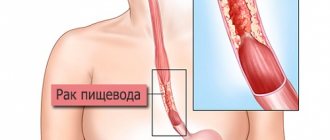Pylorospasm is a spasmodic phenomenon in the stomach at the point of its exit into the duodenum. The disease is characterized by vegetative dystonia; in children it often goes away on its own after the nervous system matures. This condition is most dangerous in infancy, when excessive vomiting can cause severe dehydration of the child’s body. Pylorospasm in children and newborns responds well to treatment with diet and medication.
Symptoms
With pyloric spasm, infants experience excessive regurgitation and vomiting a few days after birth. This reflex can occur immediately after feeding or after 10-15 minutes. In this case, the discharge resembles curdled milk. Their mass exceeds the amount of food consumed by the child.
Sometimes vomiting does not occur, but uneven regurgitation is observed. The child is slowly gaining weight. Possible stool problems in the newborn. With frequent regurgitation, the volume of urine decreases. The general condition of the child is satisfactory. With proper diagnosis, the problem can be dealt with quickly, but the lack of qualified help threatens the development of malnutrition.
Symptoms
Most often, symptoms of pylorospasm appear immediately after birth. A few breastfeedings are enough to detect problems with milk absorption. In rare cases, the disease is diagnosed not in newborns, but in infants under the age of 1 year. The signs of pathology have their own characteristics.
It is difficult for parents to independently identify the symptoms of pathology, so it is advisable that the newborn be under the supervision of a doctor at first. Although the main signs of pylorospasm are considered to be excessive regurgitation and periodic vomiting, they develop gradually.
First, symptoms appear such as loose stools, bloating, colic, in which the child is capricious and does not allow his tummy to be touched. Over time they develop:
- poor weight gain – the child’s body weight does not reach normal levels;
- excessive regurgitation after each feeding, parents get the impression that all the food they have taken is coming out;
- restlessness, moodiness, frequent crying;
- sleep disorders;
- constipation;
- pale skin, lack of interest, apathy.
In newborns, pylorospasm of the primary form is more often diagnosed - the pathology develops independently.
In infants and older children who did not have pyloric spasm at birth, a secondary form of pathology develops. It is provoked by diseases of other gastrointestinal organs. In this case, the symptoms are similar, but all signs of disturbances in the work of the pylorus develop more intensively, complications arise:
- body weight deficiency reaches critical levels;
- profuse vomiting occurs more and more often;
- due to constant constipation and vomiting, diseases of the digestive system develop, associated with stagnation of feces and inflammatory processes.
Sometimes pylorospasm in infants can be congenital, but due to mild symptoms, it begins to appear months later in the child’s life.
The essence of disrupted gastrointestinal tract function
The reverse direction of food from the stomach to the esophagus - this is how pylorospasm in infants can be characterized. The symptoms listed above indicate the presence of a disorder. In case of birth oxygen deficiency, there is a possibility that the baby will develop a disorder. Therefore, early diagnosis and treatment of pylorospasm in children is so important. Pyloric stenosis is a secondary manifestation of a vascular or parasitic disease. It is a consequence of an untreated illness.
Most often, pylorospasm in infants occurs due to relaxation of the sphincter in the lower part of the esophagus. In children, its final formation occurs at 3 years. At an early age, it is not fully developed, which means that the process of emptying the stomach is delayed. The initial stage of the disease is characterized by a loosened state of the esophageal mucosa, its redness and decreased sphincter tone. If left untreated, plaque forms on the mucous membrane. This leads to erosions and wounds. As a result of inactivity, pyloric stenosis develops in the newborn.
Features of the gastrointestinal tract in children
After birth, babies' stomachs still have a very thin and delicate mucous membrane, and the muscles of the gastrointestinal tract are not yet sufficiently developed and elastic. The secretory function also does not work well; little gastric juice is secreted, which contains a small amount of enzymes that help digest food.
If the picture does not change with age and the amount of gastric juice does not increase, then problems may arise.
The mucous membrane in the mouth is also not yet fully mature. Until 3-4 months, the baby does not produce saliva well. Afterwards everything changes, and saliva is produced in sufficient quantities. However, the child may develop physiological drooling due to the fact that he has not yet learned to swallow it.
The esophagus in infancy is funnel-shaped, the stomach has a small volume - 30-35 ml, but it increases every month. The cardiac sphincter in babies is also very weak, which often leads to frequent regurgitation. The composition of gastric juice is the same in adults and children, but the latter still have a very low barrier function after birth. And in order for the child to have problem-free digestion, hygiene and dietary requirements for the nutrition of infants should be especially carefully observed.
In children who are bottle-fed, the secretory apparatus of the stomach develops much faster. This happens because the stomach copes with food that is difficult to digest and is not typical for nutrition at this age. You need to be very careful with mixtures so as not to disturb digestion.
Cause-and-effect relationships
Why does pylorospasm occur in infants? There is no exact answer to this question. Scientists say that spasms appear due to incorrect position of the sphincter or pressure on it. In addition, the reasons for the development of pylorospasm include:
- Impaired secretion production of the digestive glands.
- Insufficient amount of gastrointestinal hormones.
- Pathology of the baby's central nervous system.
With the correct actions of the mother during regurgitation, pyloric spasm can disappear in the baby at the age of three months. To do this, it is enough to hold the child in an upright position. But there are cases when vomiting and regurgitation continue for several years. As a result, pylorospasm in children acquires a serious form. Symptoms, diagnosis, treatment and prevention in this case are individual. The advanced form of the disorder cannot be treated with medication. In this case, surgery is required.
Causes
It is difficult to accurately determine the causes of pylorospasm in children. A child is born with existing disturbances in pyloric contraction. Doctors explain that pylorospasm in newborns is associated with the following factors:
- genetic predisposition - if the parents have pylorospasm, the likelihood of it developing in the baby is high;
- underdevelopment of the central nervous system – pylorospasm;
- baby injuries received during childbirth;
- hypoxia;
- infectious diseases suffered by a woman during pregnancy;
- hypoxia;
- developmental anomalies of the gastrointestinal tract, including the pylorus.
Premature birth is considered one of the most common causes. If at the time of birth the baby’s gastrointestinal tract organs have not yet fully developed, the likelihood of complications developing is high. In such cases, along with pylorospaz, other pathologies of the digestive system are often diagnosed.
Why does this happen?
Food from the esophagus enters the stomach, from which it is sent to the duodenum through a small opening called the pylorus or pylorus. There is a significant layer of muscle in this area. When the muscles contract, the passage between the stomach and intestines closes. If the pylorus does not function properly, food does not move well from the stomach to the intestines. And under the influence of pressure it penetrates outward - vomiting occurs. This process is called pylorospasm.
In newborns, this is associated with a disorder of the central nervous system and the presence of hypertonicity. In addition, when the mother is exposed to nicotine, alcohol or medication, pylorospasm also occurs in infants. Reviews from women indicate that external stimuli also often lead to the occurrence of this disorder. For example, if something frightened the baby.
Types of pathology
Depending on the time of occurrence, pylorospasm can be:
- primary;
- secondary.
Pyloric spasm can occur in two forms:
- compensated, when the efforts of the stomach overcome the spasm and food passes through the spasmodic area;
- decompensated, when the walls of the stomach do not contract and food stagnates.
The nature of the spasm is:
- absolute, when the hole is completely blocked by muscles;
- incomplete, when the hole narrows significantly, but does not close completely.
How to recognize the disease?
For effective therapy, it is necessary to determine at an early stage the presence of a diagnosis of “pylorospasm” in infants. Treatment is prescribed only by a doctor. Differential diagnosis is carried out. Its results help distinguish the signs of pylorospasm from other disorders. Vomiting and regurgitation in newborns can occur for the following reasons:
- Overfeeding. There is profuse vomiting of liquid milk.
- Increased gas formation. The problem can be detected using an x-ray.
- Shortened esophagus.
- Achalasia of the esophagus.
- Stenosis and atresia.
- Fistula.
- Poor gastrointestinal tract obstruction.
The results of the examination will help the doctor prescribe an effective course of treatment that will help improve the functioning of the gastrointestinal tract. So, if a baby periodically experiences a gag reflex, during which curdled milk is released abundantly, then immediate consultation with a specialist and an ultrasound examination of the stomach and esophagus are necessary. Ultrasound results help identify pylorospasm in infants.
Pylorospasm and gastric stenosis: differences
Pyloric contractions and regurgitation of milk indicate pylorospasm in newborns. The symptoms of this disorder are similar to gastric stenosis. Pain and discomfort make the child capricious and whiny. In addition, there is a constant desire to vomit. As the disorder progresses, the baby loses weight and becomes weaker. Regurgitation becomes constant. The height of the disease is characterized by frequent vomiting, dry skin, and diarrhea. This distinguishes gastric stenosis from ordinary pylorospasm. By the way, the first disease is much more complicated. It has its own distinctive symptoms and is often an advanced form of pylorospasm.
Treatment
Each child has individual symptoms. And the treatment of children diagnosed with pylorospasm is selected individually. At the initial stage, they try to eliminate the disorder without the use of medications. Experts recommend that mothers give their babies alkaline mineral water after each feeding. The one-time dose of liquid should not exceed 2 teaspoons. Water is a necessary condition after each breastfeeding or artificial feeding.
You can't overfeed your baby. It is advisable to use a fractional feeding method to avoid excessive regurgitation. After the toddler has eaten, it must be held upright until it burps. When artificial feeding, you need to carefully select the mixture. The finished milk must contain a special thickener.
In the acute form of pylorospasm, the doctor prescribes medications that have the following effects:
- antispasmodic (most often these are various drops);
- sedative or calming;
- vitamin.
Treatment is carried out under the supervision of medical staff in the hospital. In special cases, physiotherapy or paraffin therapy is prescribed. If we talk about the course of the disease, the baby’s condition, if all the rules are followed, is often satisfactory. Qualified and timely assistance guarantees quick healing. In the future, the mother just needs to monitor the child’s condition to prevent pylorospasm from occurring again.
Differential diagnosis of the disease
Since the clinical picture of the disease is similar to many pathologies, differential diagnosis is required. With pylorospasm, the diagnostic criteria are somewhat different. Initially, the doctor interviews and examines the patient. The results of such an examination are not enough to make a diagnosis of pylorospasm.
As an additional examination, doctors prescribe laboratory testing of physiological fluids. This type of study is not particularly informative, since in the initial stages of pylorospasm, the indicators in the analyzes remain unchanged.
In complicated forms of pathology with pylorospasm, tests reveal: anemia, chloremia. Urine has a light color, with a low specific gravity. The main diagnostic methods for pylorospasm are instrumental examination.
Interview and examination of the patient
When interviewing a patient, the doctor clarifies whether the patient has chronic diseases. If there are no such pathologies, then it is important to establish when vomiting first appeared. In addition, it is important to clarify whether surgical interventions were performed in the abdominal cavity; this is necessary to exclude the development of adhesions.
After the survey, the specialist examines the patient. At the same time, he palpates the abdomen in the stomach area. In addition, the condition of the skin is assessed.
Instrumental methods
To clarify the diagnosis, the doctor may prescribe instrumental research methods (when identifying pylorospasm, they are considered the most effective):
1. X-ray examination of the stomach with the introduction of contrast liquid (barium sulfate). With the development of a mild form of pylorospasm, good patency of the sphincter is observed. Most of the contrast agent passes into the intestine. Pyloric spasms are usually minor. In more severe forms, patency is impaired and stagnation of the contrast agent is observed. 2. Fibroesogastroscopy. It involves inserting an endoscope into the stomach cavity (swallowing a light bulb). In the initial stages of pathology, the endoscope easily passes into the sphincter area, and there are no food debris. When the disease is advanced, patency is impaired and food stagnation is observed.
Differentiation from pyloric stenosis
To choose the right treatment, it is important to differentiate pylorospasm from pyloric stenosis. With pyloric stenosis, fountain vomiting is observed, and with pylorospasm, a small amount of rejected fluid is released. In addition, a characteristic feature of pyloric stenosis is the presence of constipation and rapid deterioration in health.
When differentially diagnosing pylorospasm from pyloric stenosis, patients are prescribed an X-ray examination. With pyloric stenosis, prolonged spasms of the pylorus are observed. The pathogenic area looks like a thin thread. At the same time, taking antispasmodics does not make the patient feel better.
Carrying out endoscopy for pyloric stenosis allows you to diagnose changes and hypertrophy of muscle tissue.
It is important to know!
A special role in the prevention or treatment of pylorospasm in infants is played by the fight against overeating and forced feeding. It is imperative to keep the baby in an upright position after eating so that excess air escapes. Experts say that pyloric spasm can often be confused with pyloric stenosis, which has similar symptoms. But it is important to know that these are two different diseases. They differ in development mechanisms. And the treatment will also be different. They try to eliminate pyloric spasm with the help of medications, and pyloric stenosis with surgery.
Food is better digested under the influence of alkaline water. This is why it is so important to give your baby something to drink after every feeding. It is important to know that in the absence of proper treatment, the disorder develops into a complex form - pyloric stenosis. It is characterized by complete damage to the gastrointestinal tract, which irreversibly leads to surgical intervention. Remember that diseases do not go away on their own. Therefore, do not ignore the symptoms, but seek medical help immediately.











